Here’s what all those cycles on your dryer actually do
The four major dryer cycles go head-to-head
 Credit:
Credit:
Products are chosen independently by our editors. Purchases made through our links may earn us a commission.
The dryer is really the unsung hero of the home appliances. It’s not a glamorous or sexy product, but without it, everyone would spend a lot more time and effort tending to wet laundry as it dangles on clotheslines. While that’s doable for some people, it’s not for everyone.
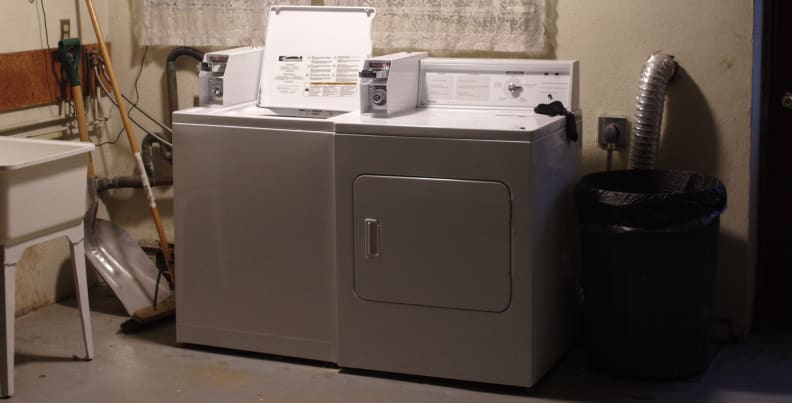
Every basement in every apartment building, ever.
So really, the humble clothes dryer is an amazing, time saving product that sits, unheralded, in your basement or in your laundry room. But what does a dryer actually do?
"Well, it spins."
Indeed it does!
Wet clothes are placed in a hollow metal drum that is rotated by a system of belts and pulleys. At the back of the drum are the heating elements (heat going in), thermostats (measuring the temperature of the air), and exhaust duct (air going out). Exceptions to this general setup are ventless or heat pump dryers.
The weight of the wet clothes causes them to stick to the outside of the drum until they reach the apex of the drum’s spin, and then the wet laundry falls back towards the bottom of the drum again.
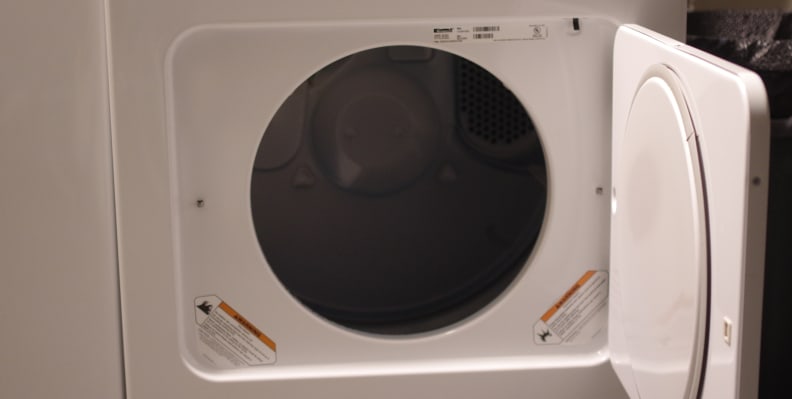
RIP many socks
There are two reasons why a spinning drum will help to dry your clothes. Firstly, by collapsing wet laundry on top of itself or on the metal drum, the collision releases moisture from the wet cloth into the air. The heating unit then heats up that air as well as the laundry, and causes the moisture to evaporate; this reduces the overall amount of moisture in the drum, and prevents it from re-wetting the laundry.
Secondly, by spinning, the dryer drum exposes more of the laundry’s surface area to the heating elements at the back of the dryer. If a pile of wet laundry were completely stationary, it would take a lot longer to completely dry the wet items furthest from the heat source.
"But if the spinning part is always the same, then why are there different dryer cycles?"
Great question! There are four major dryer cycles that we test, here at Reviewed: Normal, Heavy, Quick, and Bulky.

Examples of the possible cycles on a dryer. "normal" is the normal cycle, "bedding" is the bulky cycle, "rapid dry" is the quick cycle, and "delicates" is the delicates cycle.
Between the four major cycles, there are two variables: the cycle duration and the temperature of the air. To investigate the differences in these cycles, I pulled temperature data that we collected in the course of testing for one dryer. Read on for more info.
Normal cycle
Cycle duration: ~2 hour, 40 minutes
Peak temperature: ~150°F
The normal cycle is generally the workhorse of the dryer loads. Whether you’re running it once a day or once every two weeks, this is the cycle most people use for everyday drying of a regular load of laundry. But what is actually happening inside the dryer during a normal cycle? The chart below shows how temperature varies with time.
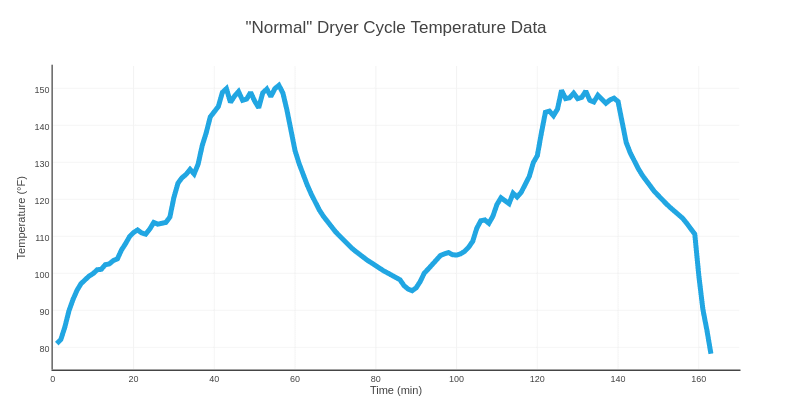
Temperature data for the normal cycle.
Interestingly, it seems that there are two distinct temperature events in the normal cycle. The temperature increases gradually to a temperature of ~150°F, maintains that temperature for about 20 minutes, and then decreases back down to ~95°F before starting the pattern all over again.
This kind of temperature cycling is pretty common in appliances that are seeking to maintain a specific temperature (ovens, refrigerators, etc.) for any period of time. The idea is that to keep a constant temperature in a sealed cavity, the appliance can’t just keep cooling or keep heating indefinitely because then the temperature would steadily rise (ovens) or fall (fridges) until you’ve gotten so far away from the desired output (frozen broccoli in your fridge, charred turkey in your oven) that the appliance isn’t doing its job properly.
To that end, heating or cooling sources often power up and then power down to try to keep a steady temperature somewhere in the middle. General consensus seems to be that most clothes dryers are aiming for temperatures between 120°F and 150°F. GE explains what temperatures exist in their dryer cycles. While these temperatures are great for drying clothes quickly without destroying them, they are also high enough to kill bedbugs, among other things.
Most clothes dryers have a maximum temperature of 150°F, although higher temperature cycles do exist on some products. Usually, the higher temperatures are accompanied by more efficient hot air venting, as overheating your clothes can cause damage and shrinkage over time.
Quick cycle
Cycle duration: ~30 minutes
Peak temperature: ~145°F
The quick cycle is the Hail Mary of dryer cycles. Using detergent and stain remover magic, you managed to get the cocktail sauce out of your favorite white clubbing pants, but can they be dried fast enough to get you out the door on time? The quick cycle saves the day! Here’s what the temperature variation looks like throughout the cycle.
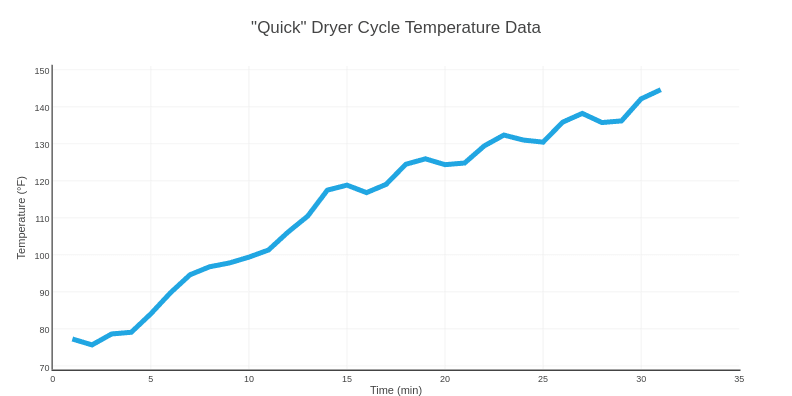
Temperature data for the quick cycle.
Unsurprisingly, the quick cycle is not long enough to have the distinct temperature variations seen in the normal cycle. However, the quick cycle still has to fulfill promises about getting clothes dry in a short amount of time. To do this, the cycle ramps up the temperature much faster (about ten minutes faster) than it does in the normal cycle.
Delicates cycle
Cycle duration: ~2 hours, 30 minutes
Peak temperature: ~120°F
The aptly-named delicates cycle is ideal for fabrics that cannot take as much wear-and-tear as your usual clothes. Athletic clothes, lingerie, and things made out of linen are some candidates for the delicates cycle. The chart for the temperature variation in the delicates cycle is shown below.

Temperature data for the delicates cycle.
Because items in the delicates cycle require much more careful handling, the maximum temperature of the delicates cycle is about 120°F. This lower temperature is just hot enough to dry and de-wrinkle clothes, but not to do any more damage. While cotton t-shirts and jeans can take higher temperatures, lingerie definitely cannot. Also, once it’s up to temperature (~120°F), the temperature variability is much smaller than that seen in the normal cycle. These clothes must still get dry, however, so the cycle duration is on par with the normal cycle in order to compensate for the reduced temperature.
Bulky cycle
Cycle duration: ~4 hours, 45 minutes
Peak temperature: ~140°F
The bulky cycle is the perfect cycle for those feeling especially ambitious. Want to wash a comforter, a bunch of full-sized towels, or the bed linens from multiple beds? If so, the bulky cycle will save your sanity. The chart for the temperature variation in the bulky cycle is shown below.
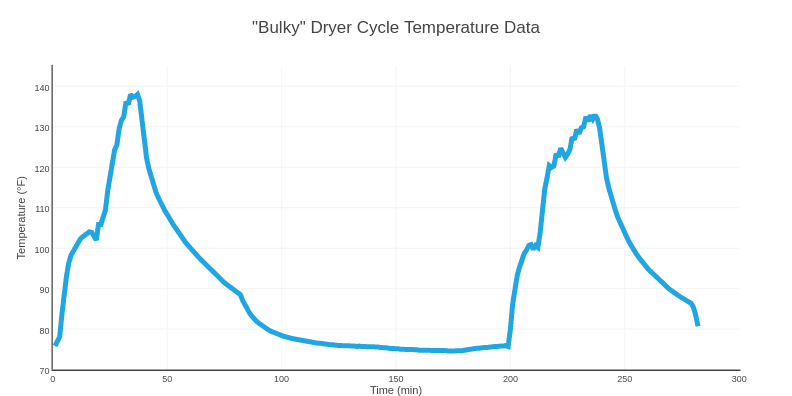
Temperature data for the bulky cycle.
The temperature data from the bulky cycle actually hints at those patterns seen in the quick and normal cycles. There are two distinct heating and cool down periods in the cycle (like the normal cycle), but it takes a relatively short time to get up to the maximum temperature (like the quick cycle). Because it’s not really recommended for temperatures to get higher than 150°F, the bulky cycle still gets large items dry by having a cycle time that’s nearly double that of the normal cycle.
The chart below shows the temperature data from all four cycles, so that you can see how the cycles compare to one another.
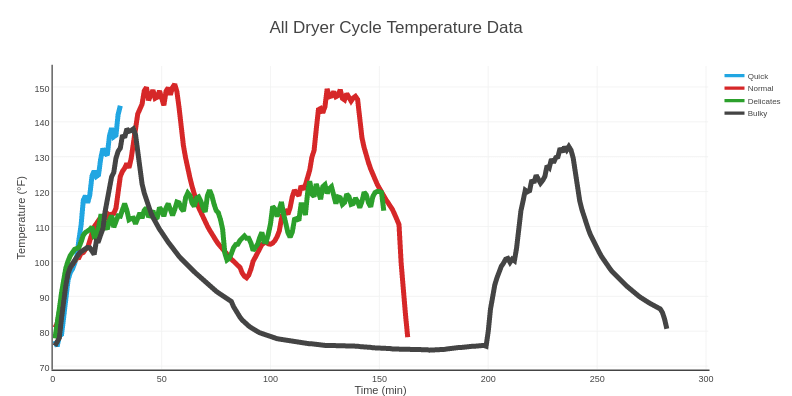
Temperature data for all four cycles.
So while sitting and watching your dryer run for hours in admiration might be a bit excessive, next time you drop a bunch of wet clothes your dryer, take a moment to appreciate the thought, the science, and the technology that goes into the creation and operation of an appliance that saves you tons of time, despite living in your creepy basement.
